Competition for AI talent has reached extraordinary levels. Reports suggest some early-career researchers are being offered pay packages rivaling those of professional athletes. In one highly publicized case, Meta allegedly dangled more than $250 million in cash and stock options to secure a single researcher.
What explains this surge? While the broader labor market has cooled the past year, especially within high-skilled professional & business services occupations—one category stands out: Computer and Information Research Scientists. This occupation includes job titles like Machine Learning Engineer or Artificial Intelligence Engineer—the type of roles exacting such eye-watering compensation packages.
On the demand side, firms across tech and beyond are racing to secure scarce AI expertise, viewing it as a critical competitive edge. On the supply side, the pool of qualified workers remains small, with years of specialized training required to produce new entrants. The result is a brewing AI talent war that shows little sign of cooling, even as other parts of the labor market ease.
Hiring demand is booming
In just 18 months, monthly postings for AI researchers have more than doubled and momentum shows little sign of slowing. This stands in sharp contrast to the broader tech labor market; hiring demand peaked during the 2022 boom, but postings for software developers, product managers, and data scientists have since trended downward.
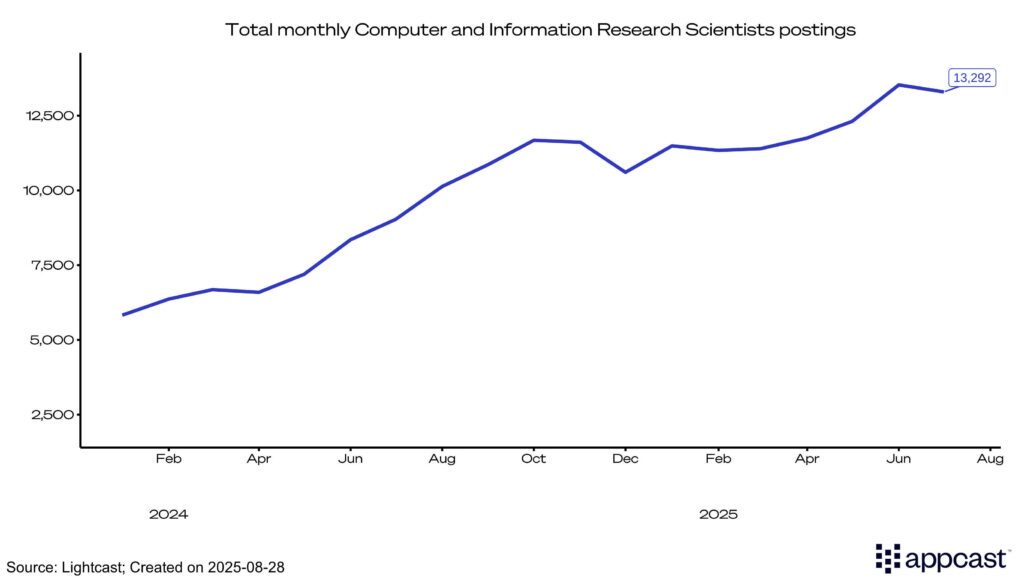
Across industries and metro areas, postings for research scientists have surged from the first half of 2024 to the first half of 2025. Lightcast data shows two standout cases: Minneapolis and Charlotte, where demand more than doubled in just one year.
This is a significant shift. For years, the Bay Area, Seattle, and New York dominated hiring for computer science researchers. Demand is bubbling up in the Midwest and Southeast as well, suggesting that the AI talent war is no longer confined to the coasts. Employers across regions are competing to secure expert talent, intensifying the pressure on already thin labor supply.
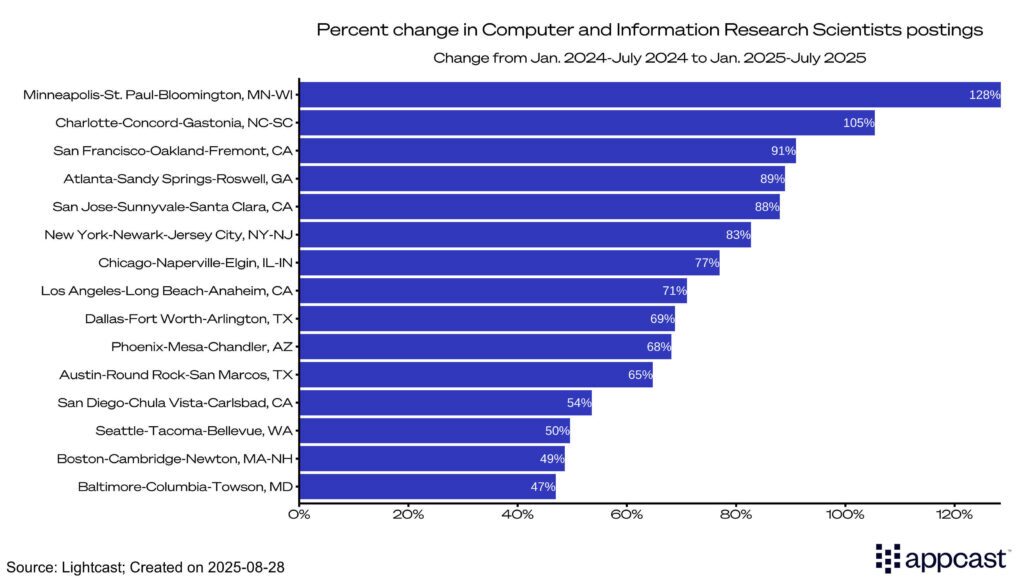
This can be partly explained by more significant investing on the part of non-traditional tech companies. Recently, for example, both Target and Walmart rolled out plans in their earnings reports to build AI tools to improve the efficiency of their workforce.
The surge in demand is also reshaping the content of job postings. Indeed’s AI tracker shows that the share of postings mentioning AI skills has doubled in most countries. In the U.K., fewer than 2% of postings included AI requirements just a year ago; today, that figure is closer to 4.5%.
The trend is rapidly accelerating. Not only is the overall volume higher, but the rate of growth suggests AI skills are quickly becoming mainstream. At this pace, it’s possible that within two years nearly one in ten job postings worldwide will reference AI, whether or not the role directly involves building machine learning models.
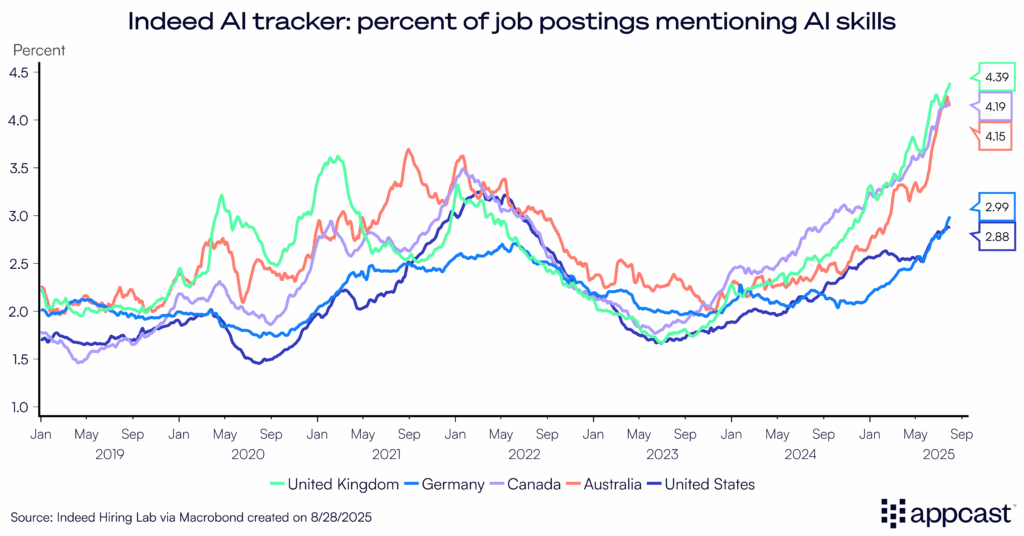
A Historic Investment Boom
Behind the hiring surge is a breathtaking wave of capital flowing into data centers and AI infrastructure. Current estimates put AI-related capital expenditures at 1.2% of GDP, surpassing the peak of telecom investment during the late-1990s internet boom.
This marks a fundamental shift in how companies allocate resources. For decades, office construction was a major driver of nonresidential investment. Before the pandemic, the U.S. spent more than $70 billion annually on new office space. Remote work quickly cut that figure down in the early 2020s, and office space spend continues to decline.
In its place, capital is being redirected toward data centers at hyper speed. Just five years ago, spending on this category was under $10 billion; today, it has quadrupled to over $40 billion and is on track to eclipse office construction entirely. It’s a striking reallocation of corporate investment, demonstrating the scale of the AI revolution.
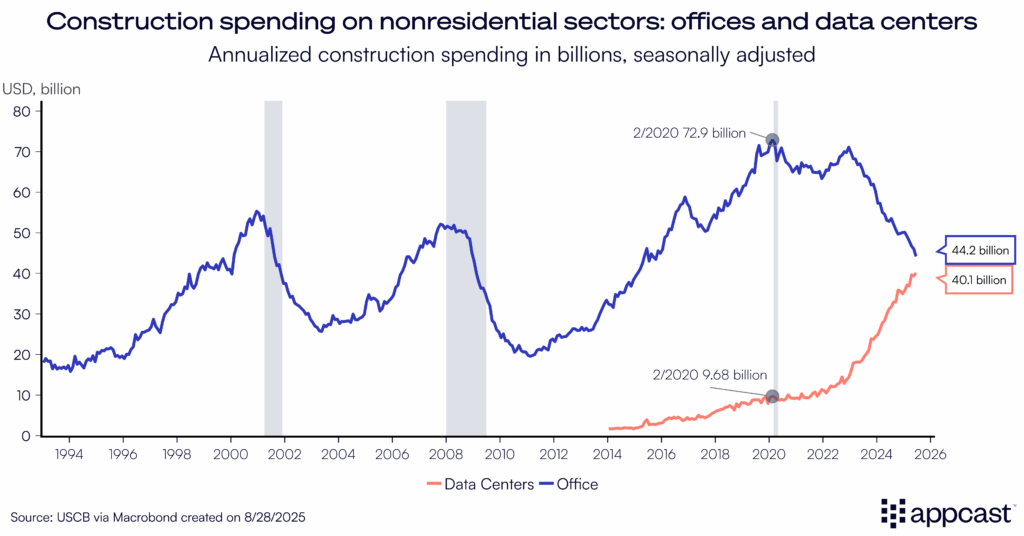
At its core, this is an arms race to build and ramp up the computing resources needed to train large language models. The scale of investment is staggering; UBS projects global AI-related capital spending will reach $375 billion this year and climb to nearly half a trillion dollars by 2026.
A Supply Side Crunch
The intensity of competition stems from a remarkably thin talent pool. According to the 2024 Occupational Employment and Wage Statistics (OEWS) survey, fewer than 40,000 Computer and Information Research Scientists are employed nationwide across the public and private sectors.
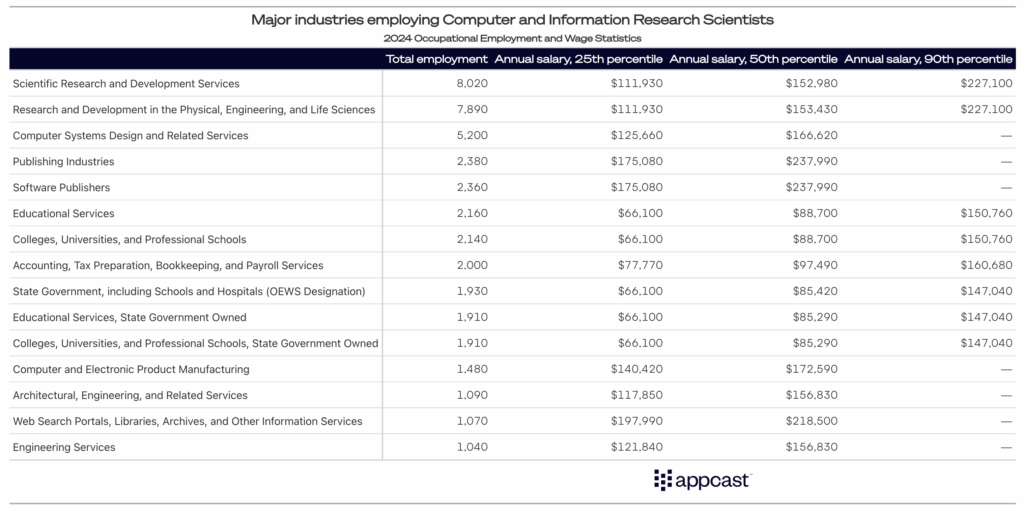
The contrast is stark. The same survey counts more than 1.6 million software developers in the U.S.—a closely related occupation but one vastly larger in scale. With such a limited number of researchers available, it’s no surprise that salaries are soaring and employers are battling fiercely to secure scarce AI expertise.
Total compensation for AI researchers can reach incredible heights: the top 10% of workers in the tech industry have an average annual salary of nearly $230,000. Advertised wages (those pulled from active job postings) for the top 10% of Computer and Information Research Scientists show a combined salary and stock compensation plan of nearly half a million dollars, according to Lightcast.
In short, the AI talent market is being squeezed from both sides: unprecedented employer demand colliding with a razor-thin supply of qualified researchers. The result is eye-popping compensation, aggressive recruiting, and a labor market dynamic unlike almost any other occupation.
But as remarkable as these labor pressures are, the bigger story lies in what this talent is being hired to build. The next frontier is not just about building data centers, but the types of tasks AI can perform more efficiently than humans and what that unlocks for productivity, economic growth, and the future of work over the rest of the century.
What does the future look like?
Just this week, Stanford researchers released a paper quantifying the early labor-market impacts of AI (with a great Substack summary). Their headline finding: employment levels are declining are among 22–25-year-olds in occupations with high AI exposure by analyzing millions of payroll records from ADP.
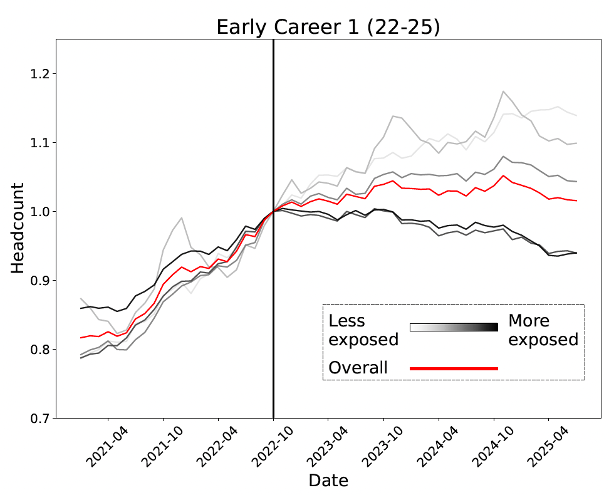
Much has been written about the struggles facing young workers, often with more speculation than evidence. Yet, youth unemployment has risen sharply in many countries at the same time AI investment has accelerated.
The challenge is untangling cause and effect. Is this primarily a story of weaker white-collar hiring demand in the post-pandemic economy or an early signal of a major productivity shock reshaping the types of jobs available?
Before this paper, it was relatively easy to assume the weakness in youth employment was simply cyclical, with companies pulling back on early talent as white-collar hiring slowed. But the new evidence suggests something more structural may be at play. AI adoption appears to be directly influencing demand in occupations with high exposure, such as software development.
In occupations where AI use leans heavily toward automation, such as software development, employment for the youngest workers has fallen noticeably. But the pattern looks different in roles where AI is primarily used to augment work, like learning new skills or developing strategy. In those cases, the impact on early-career employment is far less severe.
This divergence is key. AI is not hitting all white-collar work equally: so far it depends on whether the technology substitutes for tasks or enhances them. That’s the foundation for understanding how task exposure will shape the labor market in the years ahead.
The early evidence points to a labor market being reshaped along two tracks. For some young workers, particularly in roles where AI substitutes for tasks, opportunities are already shrinking. For others, especially in jobs where AI augments decision-making and strategy, the effects are more muted.
But for certain employers, the calculus is the same: AI is a transformative productivity shock. Firms that deploy it fastest stand to gain a competitive edge; those that lag risk being left behind. That urgency helps explain the staggering salaries and bidding wars for AI researchers. The talent war is about securing the knowledge needed to unlock the next wave of productivity.








